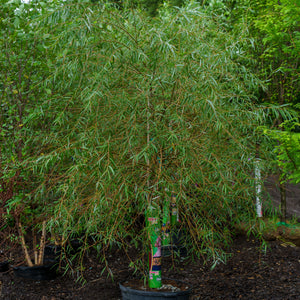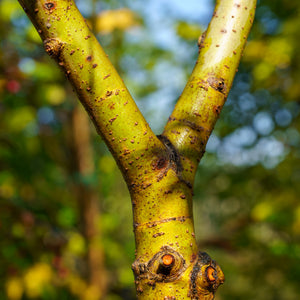The Willow Guide
Willow trees offer a graceful and timeless presence in any landscape. With their slender form, cascading branches, and delicate leaves, willow trees exude an enchanting charm that enhances the beauty of gardens and outdoor spaces. These remarkable trees are celebrated for their adaptability and can flourish in diverse conditions with the right care and attention. Whether you aspire to cultivate a serene natural oasis or wish to introduce a captivating focal point in your garden, willow trees stand as an excellent choice.
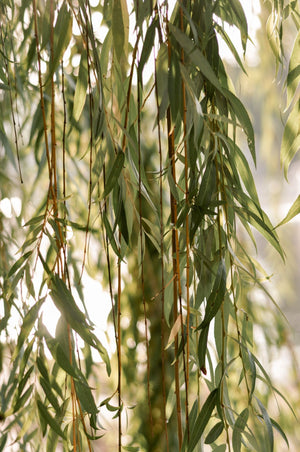
About
Willow trees, part of the Salix genus, encompass a diverse group of deciduous trees renowned for their captivating presence and ecological significance. With over 400 recognized species, willow trees can be found across temperate regions in the Northern Hemisphere, including North America, Europe, and Asia. These magnificent trees are distinguished by their unique attributes and their essential role in supporting local ecosystems.
One of the distinctive characteristics of willow trees is their flexible and often slender branches, which bear slender, lance-shaped leaves, adding to the overall elegance. The leaves of willow trees typically display varying shades of green during the growing season. In the fall, they undergo a stunning transformation, showcasing a range of warm and golden hues, including yellow and ochre.
Willow trees are celebrated for their ecological importance, providing sustenance and shelter for a wide array of wildlife. Their flowers, which appear as catkins, offer an early source of nectar for pollinators like bees and other beneficial insects. Additionally, the seeds of willow trees, encapsulated within small capsules, serve as valuable nourishment for numerous birds and mammals.
These versatile trees can adapt to various soil types and environmental conditions. While they prefer moist and well-drained soil, willow trees can thrive in both full sun and partial shade. Their resilience in the face of different climatic conditions and their relatively fast growth rate make them an excellent choice for a variety of landscaping projects.
Whether employed as a graceful focal point in a garden, planted in clusters to provide natural screens, or integrated into mixed borders, willow trees infuse an air of charm and grace into any landscape. Various species of willow trees, including the weeping willow (Salix babylonica) and the white willow (Salix alba), are renowned for their picturesque appearance and substantial contributions to local ecosystems.
By thoughtfully selecting and nurturing willow trees in your landscape, you not only enhance the aesthetic allure of your outdoor space but also actively participate in conserving these remarkable trees and the rich biodiversity they support.
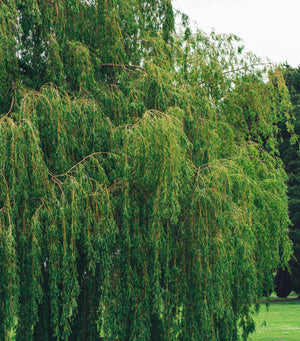
Planting
Willow trees require specific care to ensure their optimal growth and health. Here are some general guidelines for planting and caring for willow trees:
Soil: Willow trees thrive in well-drained soil that retains moisture. They adapt well to a variety of soil types, but they prefer consistently moist ground. Prior to planting, prepare the soil by loosening it and incorporating organic matter, such as compost or well-rotted manure, to enhance fertility and moisture retention. This helps ensure your willow tree has access to the nutrients it needs.
Sunlight: Willow trees are relatively flexible when it comes to light conditions. While they prefer full sun, they can also thrive in partial shade. When choosing a planting location, aim for at least six hours of direct sunlight each day to encourage robust growth. However, willows can adapt to shadier spots, making them versatile additions to your landscape.
Watering: Adequate watering is essential during the early stages of a willow tree's life. After planting, provide ample water to ensure the roots establish themselves. Continue with regular irrigation during the first year to promote healthy growth. It's important to water deeply, allowing the moisture to penetrate the soil and reach the root zone. The frequency of watering should depend on factors like rainfall and the soil's moisture levels. Avoid overwatering, as excessively wet conditions can lead to root problems.
Mulching: Apply a layer of organic mulch around the base of your willow tree to retain moisture, suppress weed growth, and regulate soil temperature. Utilize materials like wood chips, bark, or compost. Keep the mulch a few inches away from the trunk to prevent excessive moisture retention around the base, which can lead to rot issues.
Pruning: Willow trees, especially certain species like the weeping willow, may require more frequent pruning to maintain their shape and size. Pruning is best performed during late winter or early spring while the tree is dormant and before new growth emerges. Trim away dead or damaged branches to encourage overall tree health and maintain an appealing appearance.
By following these fundamental planting and care principles, you can ensure the successful establishment and flourishing growth of your willow trees. This will allow them to thrive and enhance the beauty of your landscape for years to come.
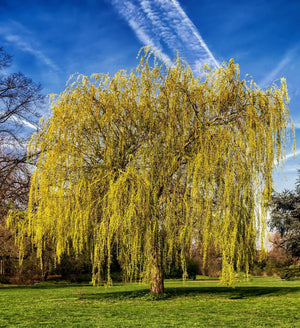
Care
Willow trees require specific care to ensure their optimal growth and health. Here are some general guidelines for the care of willow trees:
Watering: Willow trees thrive when they receive consistent moisture, especially during their growing season. Aim to provide about one inch of water per week, adjusting as necessary based on rainfall and local climate conditions. It's crucial to water deeply and thoroughly to encourage deep root development. Avoid shallow watering, which can lead to surface roots and increased susceptibility to stress and drought. In times of drought or high temperatures, be prepared to supplement with additional watering to maintain adequate soil moisture.
Pruning: Pruning willow trees can help maintain their size and form. While willows are relatively low-maintenance, it's a good practice to remove any dead or damaged branches to support the overall health and appearance of the tree. Additionally, you can prune to shape the tree according to your preferences. Late winter or early spring, before new growth appears, is the best time to prune. Ensure you use clean and sharp pruning tools to minimize the risk of harming the tree.
Fertilizing: Fertilizing can encourage healthy growth and overall tree vitality. Apply a balanced, slow-release fertilizer in the spring or early summer, adhering to the recommended application rates and timing specified by the manufacturer. Avoid over-fertilizing, as this can harm the tree's roots. It's generally safer to use less fertilizer if you are unsure about the quantity.
Soil and Sunlight: Willows thrive in well-drained soil with a consistently moist environment. While they prefer full sun, they can tolerate partial shade. When planting or caring for willows, ensure the soil provides good drainage to prevent waterlogging. Mulching around the tree's base can help retain moisture and regulate soil temperature.
Pests and Diseases: Willow trees are generally hardy, but it's still vital to be vigilant for common issues like aphids, scale insects, and leaf spot diseases. If you notice any signs of damage or disease, take swift action to treat the tree with the appropriate remedies, such as insecticides or fungicides, to prevent further harm.
By following these fundamental care guidelines, your willow trees can flourish, providing a graceful and soothing presence in your garden for years to come.
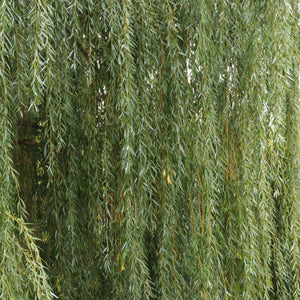
How To Use
Willow trees offer a wealth of opportunities to enhance your landscape, thanks to their versatile and graceful qualities. Here are some recommendations based on their characteristics:
Focal Point: Willow trees have an innate grace that makes them a superb choice as a focal point in your landscape. Plant a single willow tree in an open area to highlight its elegant form and cascading branches. Alternatively, create a breathtaking visual display by planting a group of willow trees together, forming an enchanting grove that captures attention.
Shade Tree: With their sweeping, drooping branches, willow trees provide exceptional shade. Strategically plant them near outdoor seating areas, patios, or decks to create cool and inviting spaces where you can unwind and savor the outdoors. The dappled shade created by willows adds a charming atmosphere to your outdoor gatherings.
Windbreak: Willow trees, known for their flexible and wind-resistant branches, excel as a natural windbreak. Arrange them in a row to shield your garden or home from strong winds, offering a practical barrier that provides protection and comfort. Their ability to sway in the breeze without breaking makes them an excellent choice for this purpose.
Privacy Screen: Harness the luxuriant foliage of willow trees to establish a natural privacy screen in your landscape. Plant them in a line along your property boundary to create an appealing and functional barrier. These screens not only enhance privacy but also elevate the overall aesthetics of your outdoor space.
Wildlife Habitat: Willow trees have an innate ability to attract wildlife. Their lush leaves, branches, and catkins provide sustenance and shelter for various creatures. Birds, insects, and small mammals are naturally drawn to willows. By planting willow trees, you invite these delightful visitors to your garden, creating a thriving habitat that enriches your outdoor experience.
When selecting willow trees for your landscape, consider their growth rate and environmental preferences. Ensure they are planted in locations that receive adequate sunlight and provide well-drained soil, especially if you aim to maintain their health and vitality. With their graceful branches and lush foliage, willow trees are an exceptional addition that enhances both the beauty and functionality of your outdoor environment.
Conclusion
Willow trees bring captivating beauty and boundless versatility to any landscape. Their unique aesthetics, graceful branches, and ecological importance make them a sought-after addition for various outdoor settings. By adhering to proper planting and care practices, you can relish the splendor and advantages of willow trees in numerous ways, whether you desire an enchanting entrance to your property or a serene sanctuary in your backyard. Whether you choose to highlight their natural elegance as a central feature or seamlessly blend them into a larger garden design, willow trees offer an array of possibilities to enhance the charm of your outdoor space. With steadfast dedication and attentive care, you can craft a magnificent landscape that will bring enduring delight for years to come.

